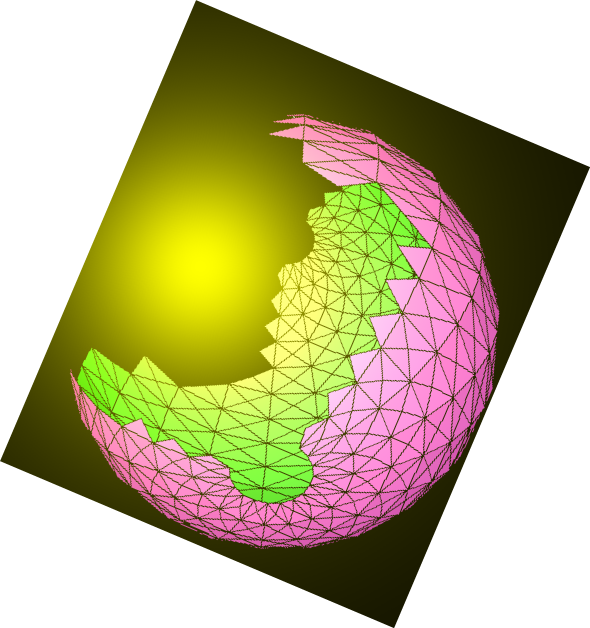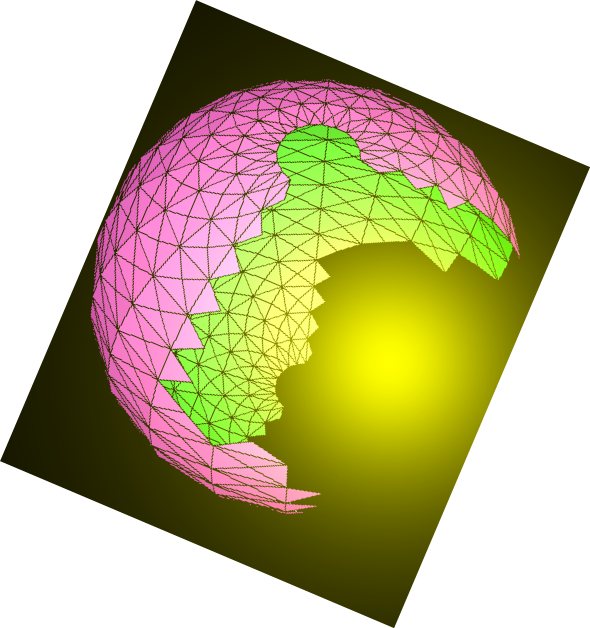
N.S.B. Cosmic Center
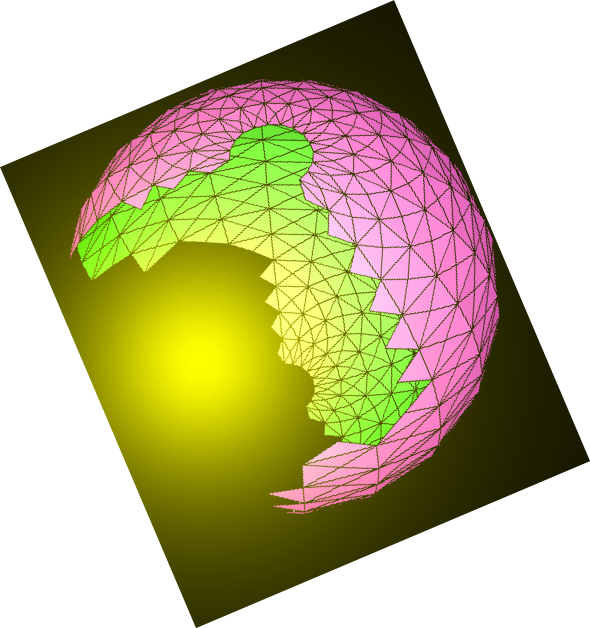
Literary Adventures
This page will take you into pieces of literature that are carefully selected for their great content at the literary, scientific, or philosophical level. A short selection will be presented in full. A long one will be divided into sections that will be refreshed regularly. Emphasis and highlights are mostly ours, not made by the original author.
Here is our current selection:
The Fairy-Land of Science (1878) by Arabella Burton Buckley
Lecture 1.
How to Enter it; How to Use it; And How to Enjoy it.
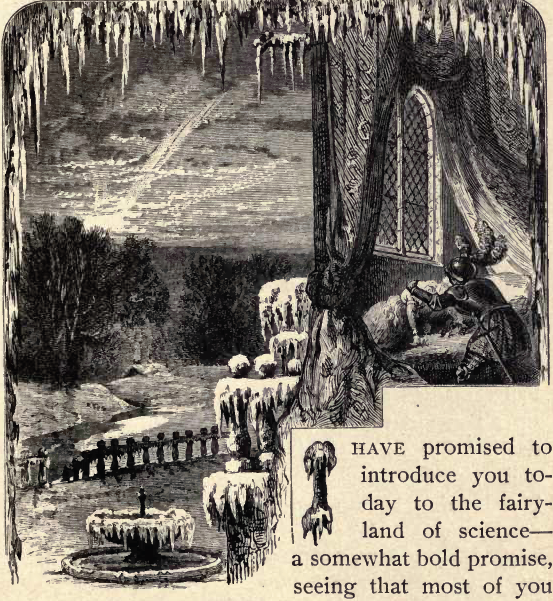
I have promised to introduce you today to the fairy-land of science,--a somewhat bold promise, seeing that most of you probably look upon science as a bundle of dry facts, while fairy-land is all that is beautiful, and full of poetry and imagination. But I thoroughly believe myself, and hope to prove to you, that science is full of beautiful pictures, of real poetry, and of wonder-working fairies; and what is more, I promise you they shall be true fairies, whom you will love just as much when you are old and greyheaded as when you are young; for you will be able to call them up wherever you wander by land or by sea, through meadow or through wood, through water or through air; and though they themselves will always remain invisible, yet you will see their wonderful power at work everywhere around you.
Let us first see for a moment what kind of tales science has to tell, and how far they are equal to the old fairy tales we all know so well. Who does not remember the tale of the "
Can science bring any tale to match this?
Tell me, is there anything in this world more busy and active than water, as it rushes along in the swift brook, or dashes over the stones, or spouts up in the fountain, or trickles down from the roof, or shakes itself into ripples on the surface of the pond as the wind blows over it? But have you never seen this water spell-bound and motionless? Look out of the window some cold frosty morning in winter, at the little brook which yesterday was flowing gently past the house, and see how still it lies, with the stones over which it was dashing now held tightly in its icy grasp. Notice the wind-ripples on the pond; they have become fixed and motionless. Look up at the roof of the house. There, instead of living doves merely charmed to sleep, we have running water caught in the very act of falling and turned into transparent icicles, decorating the eaves with a beautiful crystal fringe. On every tree and bush you will catch the water-drops napping, in the form of tiny crystals; while the fountain looks like a tree of glass with long down-hanging pointed leaves. Even the damp of your own breath lies rigid and still on the window-pane frozen into delicate patterns like fern-leaves of ice.
All this water was yesterday flowing busily, or falling drop by drop, or floating invisibly in the air; now it is all caught and spell-bound--by whom? By the enchantments of the frost-giant who holds it fast in his grip and will not let it go.
But wait awhile, the deliverer is coming. In a few weeks or days, or it may be in a few hours, the brave sun will shine down; the dull-grey, leaden sky will melt before him, as the hedge gave way before the prince in the fairy tale, and when the sun beam gently kisses the frozen water it will be set free. Then the brook will flow rippling on again; the frost-drops will be shaken down from the trees, the icicles fall from the roof, the moisture trickle down the window-pane, and in the bright, warm sunshine all will be alive again.
Is not this a fairy tale of nature? and such as these it is which science tells.
Again, who has not heard of Catskin, who came out of a hollow tree, bringing a walnut containing three beautiful dresses--the first glowing as the sun, the second pale and beautiful as the moon, the third spangled like the star-lit sky, and each so fine and delicate that all three could be packed in a nut? But science can tell of shells so tiny that a whole group of them will lie on the point of a pin, and many thousands be packed into a walnut-shell; and each one of these tiny structures is not the mere dress but the home of a living animal. It is a tiny, tiny shell-palace made of the most delicate lacework, each pattern being more beautiful than the last; and what is more, the minute creature that lives in it has built it out of the foam of the sea, though he himself appears to be merely a drop of jelly.
Lastly, anyone who has read the '
We might find hundreds of such fairy tales in the domain of science, but these three will serve as examples, and we must pass on to make the acquaintance of the science-fairies themselves, and see if they are as real as our old friends.
Tell me, why do you love fairy-land? what is its charm? Is it not that things happen so suddenly, so mysteriously, and without man having anything to do with it? In fairy-land, flowers blow, houses spring up like Aladdin's palace in a single night, and people are carried hundreds of miles in an instant by the touch of a fairy wand.
And then this land is not some distant country to which we can never hope to travel. It is here in the midst of us, only our eyes must be opened or we cannot see it. Ariel and Puck did not live in some unknown region. On the contrary, Ariel's song is
"Where the bee sucks, there suck I;
In a cowslip's bell I lie;
There I couch when owls do cry.
On the bat's back I do fly,
After summer, merrily."
The peasant falls asleep some evening in a wood, and his eyes are opened by a fairy wand, so that he sees the little goblins and imps dancing round him on the green sward, sitting on mushrooms, or in the heads of the flowers, drinking out of acorn-cups, fighting with blades of grass, and riding on grasshoppers.
So, too, the gallant knight, riding to save some poor oppressed maiden, dashes across the foaming torrent, and just in the middle, as he is being swept away, his eyes are opened, and he sees fairy water-nymphs soothing his terrified horse and guiding him gently to the opposite shore. They are close at hand, these sprites, to the simple peasant or the gallant knight, or to anyone who has the gift of the fairies and can see them. But the man who scoffs at them, and does not believe in them or care for them, he never sees them. Only now and then they play him an ugly trick, leading him into some treacherous bog and leaving him to get out as he may.
Now, exactly all this which is true of the fairies of our childhood is true too of the fairies of science. There are forces around us, and among us, which I shall ask you to allow me to call fairies, and these are ten thousand times more wonderful, more magical, and more beautiful in their work, than those of the old fairy tales. They, too, are invisible, and many people live and die without ever seeing them or caring to see them. These people go about with their eyes shut, either because they will not open them, or because no one has taught them how to see. They fret and worry over their own little work and their own petty troubles, and do not know how to rest and refresh hemselves, by letting the fairies open their eyes and show them the calm sweet pictures of nature. They are like Peter Bell of whom Wordsworth wrote:--
"A primrose by a river's brim
A yellow primrose was to him,
And it was nothing more."
But we will not be like these, we will open our eyes, and ask, "
Just go out into the country, and sit down quietly and watch nature at work. Listen to the wind as it blows, look at the clouds rolling overhead, and the waves rippling on the pond at your feet. Hearken to the brook as it flows by, watch the flower-buds opening one by one, and then ask yourself, "
There is only one gift we must have before we can learn to know them--we must have imagination. I do not mean mere fancy, which creates unreal images and impossible monsters, but imagination, the power of making pictures or images in our mind, of that
If you have this gift of imagination come with me, and in these lectures we will look for the invisible fairies of nature.
Watch a shower of rain. Where do the drops come from? and why are they round, or rather slightly oval? In our fourth lecture we shall see that the little particles of water of which the rain-drops are made, were held apart and invisible in the air by heat, one of the most wonderful of our forces** or fairies, till the cold wind passed by and chilled the air. Then, when there was no longer so much heat, another invisible force, cohesion, which is always ready and waiting, seized on the tiny particles at once, and locked them together in a drop, the closest form in which they could lie. Then as the drops became larger and larger they fell into the grasp of another invisible force, gravitation, which dragged them down to the earth, drop by drop, till they made a shower of rain. Pause for a moment and think. You have surely heard of gravitation, by which the sun holds the earth and the planets, and keeps them moving round him in regular order? Well, it is this same gravitation which is at work also whenever a shower of rain falls to the earth. Who can say that he is not a great invisible giant, always silently and invisibly toiling in great things and small whether we wake or sleep?
Now the shower is over, the sun comes out, and the ground is soon as dry as though no rain had fallen. Tell me, what has become of the rain-drops? Part no doubt have sunk into the ground, and as for the rest, why you will say the sun has dried them up. Yes, but how? The sun is more than ninety-one millions of miles away; how has he touched the rain-drops? Have you ever heard that invisible waves are travelling every instant over the space between the sun and us? We shall see in the next lecture how these waves are the sun's messengers to the earth, and how they tear asunder the rain-drops on the ground, scattering them in tiny particles too small for us to see, and bearing them away to the clouds. Here are more invisible fairies working every moment around you, and you cannot even look out of the window without seeing the work they are doing.
If, however, the day is cold and frosty, the water does not fall in a shower of rain; it comes down in the shape of noiseless snow. Go out after such a snow-shower, on a calm day, and look at some of the flakes which have fallen; you will see, if you choose good specimens, that they are not mere masses of frozen water, but that each one is a beautiful six-pointed crystal star. How have these crystals been built up? What power has been at work arranging their delicate forms? In the fourth lecture we shall see that up in the clouds another of our invisible fairies, which, for want of a better name, we call the "
And now, suppose that this snow-shower has fallen early in February; turn aside for a moment from examining the flakes, and clear the newly-fallen snow from off the flower-bed on the lawn. What is this little green tip peeping up out of the ground under the snowy covering? It is a young snowdrop plant. Can you tell me why it grows? where it finds its food? what makes it spread out its leaves and add to its stalk day by day? What fairies are at work here?
First there is the hidden fairy "
One picture more, and then I hope you will believe in my fairies. From the cold garden, you run into the house, and find the fire laid indeed in the grate, but the wood dead and the coals black, waiting to be lighted. You strike a match, and soon there is a blazing fire. Where does the heat come from? Why do the coals burn and give out a glowing light? Have you not read of gnomes buried down deep in the earth, in mines, and held fast there till some fairy wand has released them, and allowed them to come to earth again? Well, thousands and millions of years ago, those coals were plants; and, like the snowdrop in the garden of today, they caught the sunbeams and worked them into their leaves. Then the plants died and were buried deep in the earth and the sunbeams with them; and like the gnomes they lay imprisoned till the coals were dug out by the miners, and brought to your grate; and just now you yourself took hold of the fairy wand which was to release them. You struck a match, and its atoms clashing with atoms of oxygen in the air, set the invisible fairies "
This is no fancy tale; it is literally true, as we shall see in Lecture VIII, that the warmth of a coal fire could not exist if the plants of long ago had not used the sunbeams to make their leaves, holding them ready to give up their warmth again whenever those crushed leaves are consumed.
Now, do you believe in, and care for, my fairy-land? Can you see in your imagination fairy Cohesion ever ready to lock atoms together when they draw very near to each other: or fairy Gravitation dragging rain-drops down to the earth: or the fairy of Crystallization building up the snow-flakes in the clouds? Can you picture tiny sunbeam-waves of light and heat travelling from the sun to the earth? Do you care to know how another strange fairy, Electricity, flings the lightning across the sky and causes the rumbling thunder? Would you like to learn how the sun makes pictures of the world on which he shines, so that we can carry about with us photographs or sun-pictures of all the beautiful scenery of the earth? And have you any curiosity about Chemical action, which works such wonders in air, and land, and sea? If you have any wish to know and make friends of these invisible forces, the next question is:
How are you to enter the fairy-land of science?
There is but one way. Like the knight or peasant in the fairy tales, you must open your eyes. There is no lack of objects, everything around you will tell some history if touched with the fairy wand of imagination. I have often thought, when seeing some sickly child drawn along the street, lying on its back while other children romp and play, how much happiness might be given to sick children at home or in hospitals, if only they were told the stories which lie hidden in the things around them. They need not even move from their beds, for sunbeams can fall on them there, and in a sunbeam there are stories enough to occupy a month. The fire in the grate, the lamp by the bedside, the water in the tumbler, the fly on the ceiling above, the flower in the vase on the table, anything, everything, has its history, and can reveal to us nature's invisible fairies.
<>Only you must wish to see them. If you go through the world looking upon everything only as so much to eat, to drink, and to use, you will never see the fairies of science. But if you ask yourself why things happen, and how the great God above us has made and governs this world of ours; if you listen to the wind, and care to learn why it blows; if you ask the little flower why it opens in the sunshine and closes in the storm; and if when you find questions you cannot answer, you will take the trouble to hunt out in books, or make experiments, to solve your own questions, then you will learn to know and love those fairies.Mind, I do not advise you to be constantly asking questions of other people; for often a question quickly answered is quickly forgotten, but a difficulty really hunted down is a triumph for ever. For example, if you ask why the rain dries up from the ground, most likely you will be answered, "that the sun dries it," and you will rest satisfied with the sound of the words. But if you hold a wet handkerchief before the fire and see the damp rising out of it, then you have some real idea how moisture may be drawn up by heat from the earth.
A little foreign niece of mine, only four years old, who could scarcely speak English plainly, was standing one morning near the bedroom window and she noticed the damp trickling down the window-pane. "
Then again, you must learn something of the language of science. If you travel in a country with no knowledge of its language, you can learn very little about it: and in the same way if you are to go to books to find answers to your questions, you must know something of the language they speak. You need not learn hard scientific names, for the best books have the fewest of these, but you must really understand what is meant by ordinary words.
For example, how few people can really explain the difference between a solid, such as the wood of the table; a liquid, as water; and a gas, such as I can let off from this gas-jet by turning the tap. And yet any child can make a picture of this in his mind if only it has been properly put before him.
All matter in the world is made up of minute parts or particles; in a solid these particles are locked together so tightly that you must tear them forcibly apart if you wish to alter the shape of the solid piece. If I break or bend this wood I have to force the particles to move round each other, and I have great difficulty in doing it. But in a liquid, though the particles are still held together, they do not cling so tightly, but are able to roll or glide round each other, so that when you pour water out of a cup on to a table, it loses its cuplike shape and spreads itself out flat. Lastly, in a gas the particles are no longer held together at all, but they try to fly away from each other; and unless you shut a gas in tightly and safely, it will soon have spread all over the oom.
A solid, therefore, will retain the same bulk and shape unless you forcibly alter it; a liquid will retain the same bulk, but not the same shape if it be left free; a gas will not retain either the same bulk or the same shape, but will spread over as large a space as it can find wherever it can penetrate. Such simple things as these you must learn from books and by experiment.
Then you must understand what is meant by chemical attraction; and though I can explain this roughly here, you will have to make many interesting experiments before you will really learn to know this wonderful fairy power. If I dissolve sugar in water, though it disappears it still remains sugar, and does not join itself to the water. I have only to let the cup stand till the water dries, and the sugar will remain at the bottom. There has been no chemical attraction here.
But now I will put something else in water which will call up the fairy power. Here is a little piece of the metal potassium, one of the simple substances of the earth; that is to say, we cannot split it up into other substances, wherever we find it, it is always the same. Now if I put this piece of potassium on the water it does not disappear quietly like the sugar. See how it rolls round and round, fizzing violently, with a blue flame burning round it, and at last goes off with a pop.
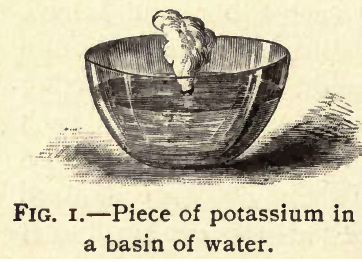
What has been happening here?
You must first know that water is made of two substances, hydrogen and oxygen, and these are not merely held together, but are joined so completely that they have lost themselves and have become water; and each atom of water is made of two atoms of hydrogen and one of oxygen.
Now the metal potassium is devotedly fond of oxygen, and the moment I threw it on the water it called the fairy "
When you can really picture this power to yourself it will help you very much to understand what you read and observe about nature.
Next, as plants grow around you on every side, and are of so much importance in the world, you must also learn something of the names of the different parts of a flower, so that you may understand those books which explain how a plant grows and lives and forms its seeds. You must also know the common names of the parts of an animal, and of your own body, so that you may be interested in understanding the use of the different organs; how you breathe, and how your blood flows; how one animal walks, another flies, and another swims. Then you must learn something of the various parts of the world, so that you may know what is meant by a river, a plain, a valley, or a delta. All these things are not difficult, you can learn them pleasantly from simple books on physics, chemistry, botany, physiology, and physical geography; and when you understand a few plain scientific terms, then all by yourself, if you will open your eyes and ears, you may wander, happily in the fairy-land of science. Then wherever you go you will find
"Tongues in trees, books in the running brooks,
Sermons in stones, and good in everything."
And now we come to the last part of our subject. When you have reached and entered the gates of science, how are you to use and enjoy this new and beautiful land?
This is a very important question, for you may make a twofold use of it. If you are only ambitious to shine in the world, you may use it chiefly to get prizes, to be at the top of your class, or to pass in examinations; but if you also enjoy discovering its secrets, and desire to learn more and more of nature, and to revel in dreams of its beauty, then you will study science for its own sake as well. Now it is a good thing to win prizes and be at the top of your class, for it shows that you are industrious; it is a good thing to pass well in examinations, for it shows that you are accurate; but if you study science for this reason only, do not complain if you find it dull, and dry, and hard to master. You may learn a great deal that is useful, and nature will answer you truthfully if you ask your questions accurately, but she will give you dry facts, just such as you ask for. If you do not love her for herself she will never take you to her heart.
This is the reason why so many complain that science is dry and uninteresting. They forget that though it is necessary to learn accurately, for so only we can arrive at truth, it is equally necessary to love knowledge and make it lovely to those who learn, and to do this we must get at the spirit which lies under the facts. What child which loves its mother's face is content to know only that she has brown eyes, a straight nose, a small mouth, and hair arranged in such and such a manner? No, it knows that its mother has the sweetest smile of any woman living; that her eyes are loving, her kiss is sweet, and that when she looks grave, then something is wrong which must be put right. And it is in this way that those who wish to enjoy the fairy-land of science must love nature.
It is well to know that when a piece of potassium is thrown on water the change which takes place is expressed by the formula
Let us take an example to show this. I have here a branch of white coral, a beautiful, delicate piece of nature's work. We will begin by copying a description of it from one of those class-books which suppose children to learn words like parrots, and to repeat them with just as little understanding.
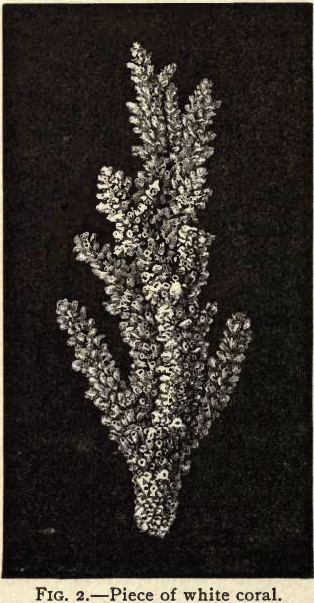
"
But now, instead of trying to master this dry, hard passage, take Mr. Huxley's penny lecture on Coral and Coral Reefs,** and with the piece of coral in your hand, try really to learn its history. You will then be able to picture to yourself the coral animal as a kind of
We cannot stop to examine all about coral now, we are only learning how to learn, but surely our specimen is already beginning to grow interesting; and when you have followed it out into the great Pacific Ocean, where the wild waves dash restlessly against the coral trees, and have seen these tiny drops of jelly conquering the sea and building huge walls of stone against the rough breakers, you will hardly rest till you know all their history. Look at that curious circular island in the picture (Fig. 3), covered with palm trees; it has a large smooth lake in the middle, and the bottom of this lake is covered with blue, red, and green jelly animals, spreading out their feelers in the water and looking like beautiful flowers, and all round the outside of the island similar animals are to be seen washed by the sea waves. Such islands as this have been built entirely by the coral animals, and the history of the way in which the reefs have sunk gradually down, as the tiny creatures added to them inch by inch, is as fascinating as the story of the building of any fairy palace in the days of old. Read all this, and then if you have no coral of your own to examine, go to the some museum and see the beautiful specimens in the glass cases there, and think that they have been built up under the rolling surf by the tiny jelly animals; and then coral will become a real living thing to you, and you will love the thoughts it awakens.
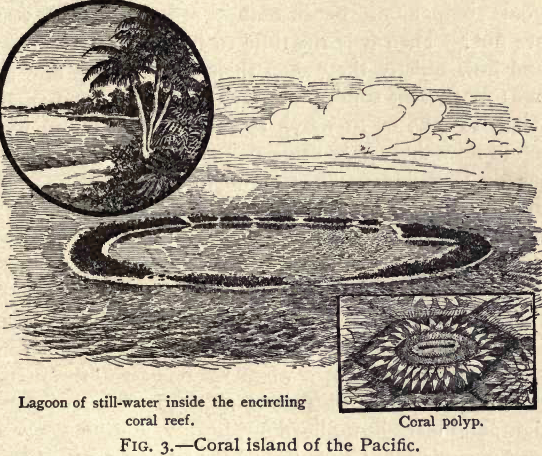
But people often ask, what is the use of learning all this? If you do not feel by this time how delightful it is to fill your mind with beautiful pictures of nature, perhaps it would be useless to say more. But in this age of ours, when restlessness and love of excitement pervade so many lives, is it nothing to be taken out of ourselves and made to look at the wonders of nature going on around us? Do you never feel tired and "
Moreover, we learn from this study to see that there is a law and purpose in everything in the Universe, and it makes us patient when we recognize the quiet noiseless working of nature all around us. Study light, and learn how all colour, beauty, and life depend on the sun's rays; note the winds and currents of the air, regular even in their apparent irregularity, as they carry heat and moisture all over the world. Watch the water flowing in deep quiet streams, or forming the vast ocean; and then reflect that every drop is guided by invisible forces working according to fixed laws. See plants springing up under the sunlight, learn the secrets of plant life, and how their scents and colours attract the insects. Read how insects cannot live without plants, nor plants without the flitting butterfly or the busy bee. Realize that all this is worked by fixed laws, and that out of it (even if sometimes in suffering and pain) springs the wonderful universe around us. And then say, can you fear for your own little life, even though it may have its troubles? Can you help feeling a part of this guided and governed nature? or doubt that the power which fixed the laws of the stars and of the tiniest drop of water--that made the plant draw power from the sun, the tiny coral animal its food from the dashing waves; that adapted the flower to the insect and the insect to the flower--is also moulding your life as part of the great machinery of the universe, so that you have only to work, and to wait, and to love?
We are all groping dimly for the Unseen Power, but no one who loves nature and studies it can ever feel alone or unloved in the world. Facts, as mere facts, are dry and barren, but nature is full of life and love, and her calm unswerving rule is tending to some great though hidden purpose. You may call this Unseen Power what you will--may lean on it in loving, trusting faith, or bend in reverent and silent awe; but even the little child who lives with nature and gazes on her with open eye, must rise in some sense or other through nature to nature's God.
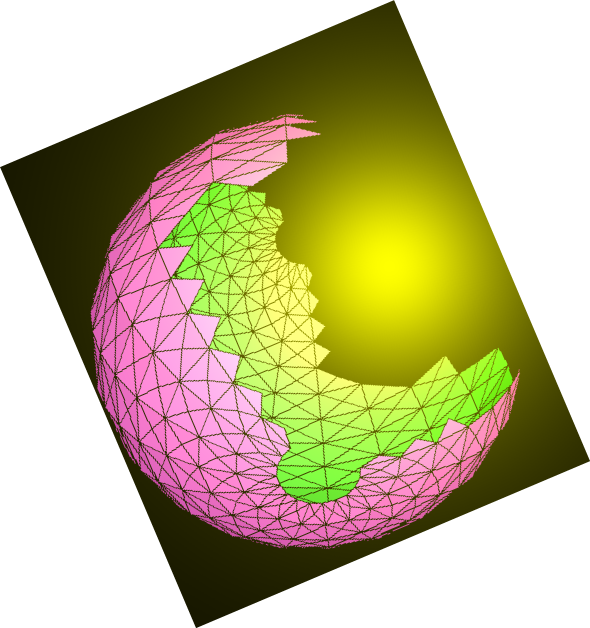
Home
N.S.B. Cosmic Center
